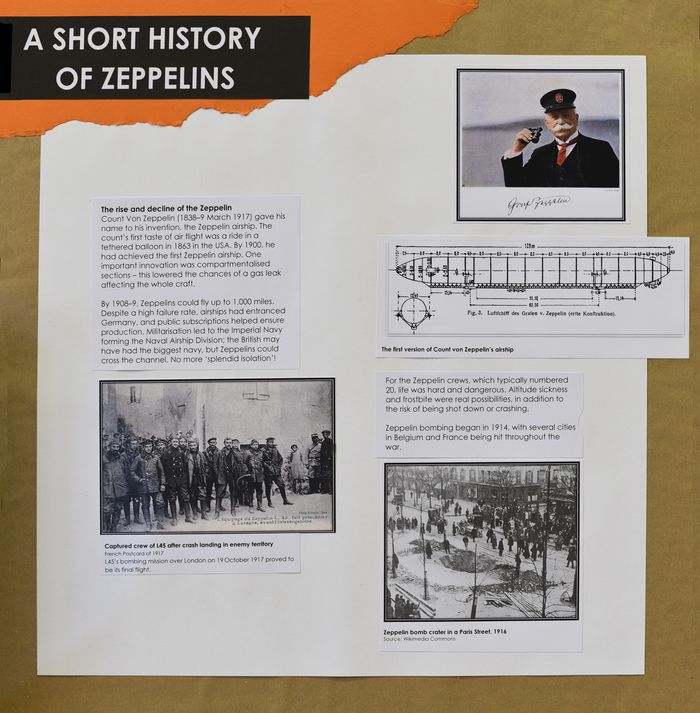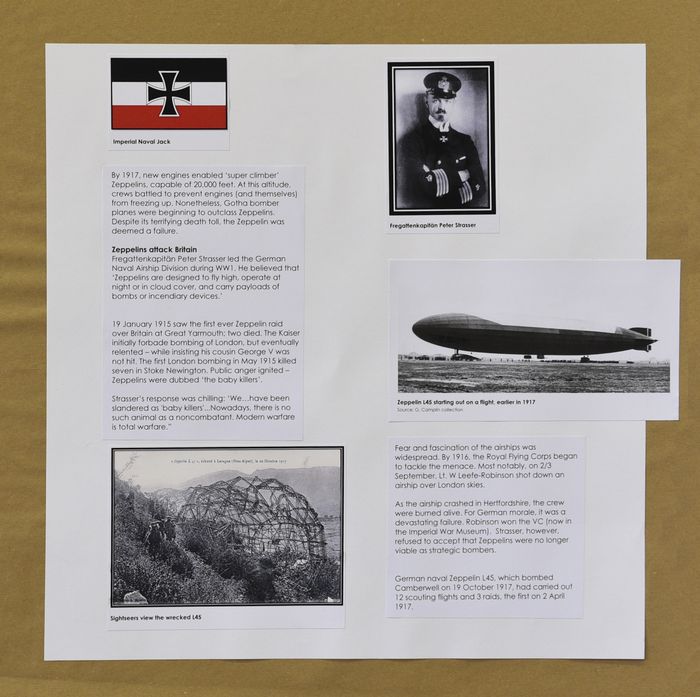Count Von Zeppelin (1838–9 March 1917) gave his name to his invention, the Zeppelin airship. The count’s first taste of air flight was a ride in a tethered balloon in 1863 in the USA. By 1900, he had produced the first ‘Zeppelin’ airship. One important innovation was compartmentalised sections – this lowered the chances of a gas leak affecting the whole craft.

By 1908–9, Zeppelins could fly up to 1,000 miles. Despite a high failure rate, airships had entranced Germany, and public subscriptions helped ensure production. Militarisation led to the Imperial Navy forming the Naval Airship Division; the British may have had the biggest navy, but Zeppelins could cross the channel. No more ‘splendid isolation’!
For the Zeppelin crews, which typically numbered 20, life was hard and dangerous. Altitude sickness and frostbite were real possibilities, in addition to the risk of being shot down or crashing.
Zeppelin bombing began in 1914, with several cities in Belgium and France being hit throughout the war.

By 1917, new engines enabled ‘super climber’ Zeppelins, capable of 20,000 feet. At this altitude, crews battled to prevent engines (and themselves) from freezing up. Nonetheless, Gotha bomber planes were beginning to outclass Zeppelins. Despite its terrifying death toll, the Zeppelin was deemed a failure.
Zeppelins attack Britain
Fregattenkapitän Peter Strasser led the German Naval Airship Division during WW1. He believed that ‘Zeppelins are designed to fly high, operate at night or in cloud cover, and carry payloads of bombs or incendiary devices.’
19 January 1915 saw the first ever Zeppelin raid over Britain at Great Yarmouth; two died. The Kaiser initially forbade bombing of London, but eventually relented – while insisting his cousin George V was not hit. The first London bombing in May 1915 killed seven in Stoke Newington. Public anger ignited – Zeppelins were dubbed ‘the baby killers’.
Strasser’s response was chilling: ‘We…have been slandered as ‘baby killers’…Nowadays, there is no such animal as a noncombatant. Modern warfare is total warfare.”
Fear and fascination of the airships was widespread. By 1916, the Royal Flying Corps began to succeed in their efforts to tackle the menace. Most notably, on 2/3 September, Lt. W Leefe-Robinson shot down an airship over London skies.
As the airship crashed in Hertfordshire, the crew were burned alive. For German morale, it was a devastating failure. Robinson won the VC (now in the Imperial War Museum). Strasser, however, could not yet accept that Zeppelins were no longer viable as strategic bombers.
German naval Zeppelin L45, which bombed Camberwell on 19 October 1917, had previously carried out 12 scouting flights and 3 raids, the first on 2 April 1917. 19 October was to be its last.
